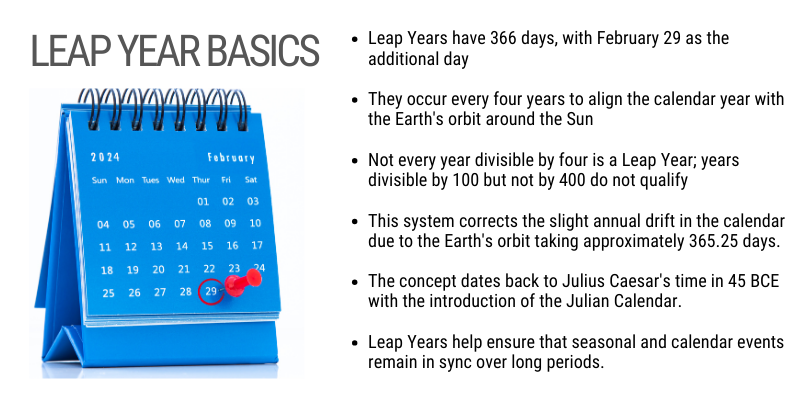What is a Leap Year?
While all years divisible by 4 are leap years, centuries (years ending in 00) are not leap years unless they are also divisible by 400
A leap year is a year that has one extra day at the end of February, making it 29 days long instead of the 28 (the non-leap years have 28 days in February). This is an adjustment that helps keep our calendar in alignment with Earth’s revolutions around the Sun.

We’ll explain it here
A Simplified history of the Leap Year

The story of the Leap Year begins with a small mismatch.
- The main problem: Earth takes 365.242 days, not exactly 365 days, to orbit the Sun. This slight difference leads to the seasons slowly drifting out of sync with the calendar over time.
- Attempts at correcting this: Ancient civilizations, like Egyptians, tried adding extra days or months to their calendars based on lunar cycles or observations, but it wasn’t consistent.
Julius Caesar’s solution: In 46 BC, Julius Caeser (a Roman king) introduced, what’s known as, the Julian calendar, which was inspired by the Egyptians.
Here’s what this calendar did:
- It added a day every four years: This day fell within February, creating a “leap day” every fourth year.
- Meant to make it accurate: By adding the extra day, Caesar wanted to keep the calendar aligned with the seasons. But, there was a small miscalculation in the length of the year, which led to a slight drift over centuries.
A fix to this in the 16th century: This built up over the years led to the calendar becoming out of sync with the seasons by about 10 days. This is when Pope Gregory XIII introduced what’s called the Gregorian calendar in 1582 to address this issue (we follow this calendar today)
Here’s what was done in the Gregorian Calendar
The Gregorian calendar kept the basic idea of adding a day every four years but with a small change.
While all years divisible by 4 are leap years, centuries (years ending in 00) are not leap years unless they are also divisible by 400. This adjustment prevents unnecessary leap years and keeps the calendar more accurate over longer periods.
Today: The Gregorian calendar is the most widely used calendar system globally. With its refined leap year rule, it ensures the calendar stays synchronized with the seasons, allowing us to plan our agricultural activities and celebrate holidays at the “right” time year after year.
The Math Behind Leap Years

The reason we need leap years is quite simple. Think of a leap year like adding a tiny bit extra to keep things in sync. Our year is based on Earth’s trip around the Sun, which takes about 365.25 days. We count 365 days in a regular year, but that extra 0.25 adds up. Every 4 years, we throw in an extra day, February 29, to catch up.
Exceptions to the Rule
While adding a day every four years seems like an easy fix, the actual solar year is slightly less than 365.25 days – it’s about 365.2425 days.
To correct this slight overcompensation, there are exceptions to the leap year rule:
Century Years: A year that is divisible by 100 is not a leap year unless it is also divisible by 400. For example, the year 1900 was not a leap year, but the year 2000 was. This rule removes three leap days every 400 years, helping to keep our calendar in alignment with the Earth’s orbit.
Leap years are a mix of astronomy, mathematics, and history, designed to keep our calendars in sync with Earth’s journey around the Sun.

Better Your Child’s G.K. In 3 Minutes – Get This Free Newsletter
Get fun facts, simple and easy news, quizzes, and lots of other interesting things to read in your mailbox – for free! It’s what we call GK-on-the-go!
I Kid You Not now has a large readership across India and also parts of the world. If you want to write for us, you can submit your story here. You can also apply to become a news anchor. Apply here



Comments